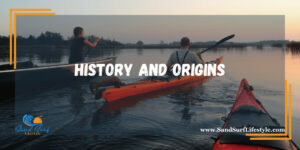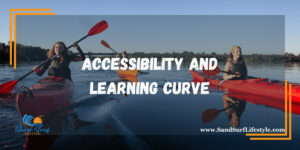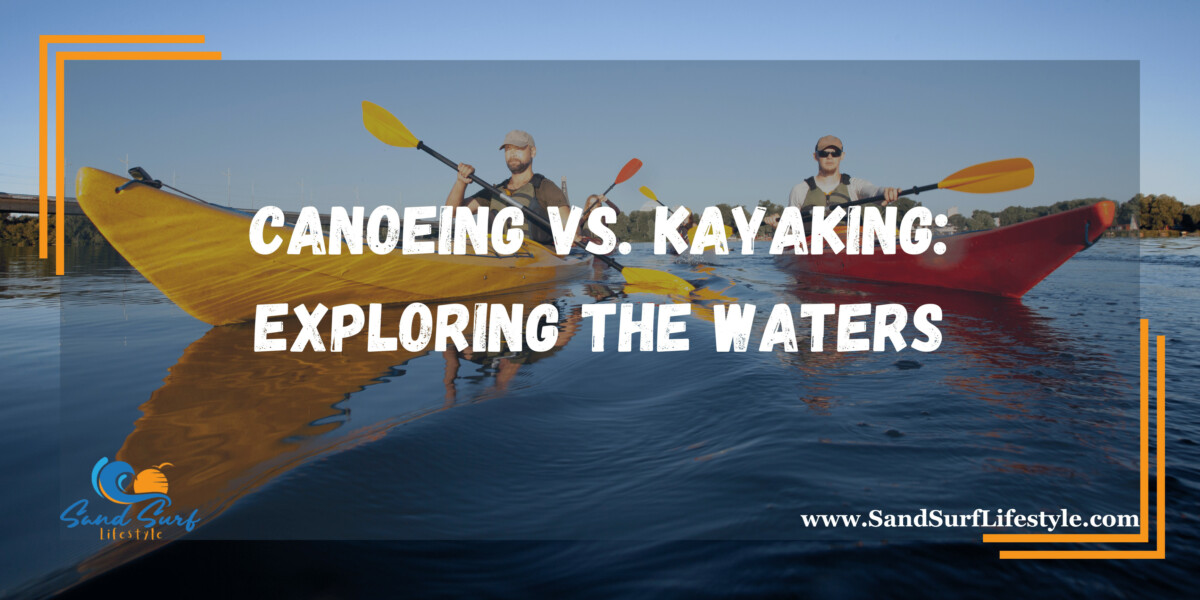When it comes to paddling through the serene beauty of rivers, lakes, and even white-water rapids, canoeing and kayaking are two of the most popular choices for outdoor enthusiasts. Both sports offer a unique way to connect with nature and enjoy the water, but they differ significantly in terms of equipment, techniques, and overall experiences.
History and Origins

To truly grasp the distinctions between canoeing and kayaking, delving into their historical origins is essential. Canoeing boasts an ancient legacy that spans thousands of years, outdating kayaking significantly. The canoe, characterized by its larger, open-top structure, has served as a vital tool for indigenous cultures worldwide, facilitating transportation and hunting. It is perhaps most famously associated with Native American tribes, celebrated for their artful construction of birch bark canoes. Over time, the form and function of canoes have evolved, yet their fundamental features have endured, representing a timeless connection to our past.
In contrast, kayaking emerges as a relatively recent entrant in the realm of water sports. This aquatic pursuit finds its roots in the frigid Arctic regions of North America and Greenland, where indigenous peoples devised kayaks for the pragmatic purposes of hunting and fishing in icy waters. Early kayaks were characterized by their compact, narrow frames, often crafted from animal skins stretched meticulously over wooden structures. The enclosed design of kayaks offered a host of advantages, including heightened maneuverability and protection from the biting cold of the Arctic environment.
Thus, understanding the historical backdrop of canoeing and kayaking unveils not only their intrinsic differences but also the diverse cultural contexts from which these waterborne traditions emerged.
To learn about the pros and cons of canoes vs. kayaks, check out this article.
Equipment
The equipment used in canoeing and kayaking represents a fundamental distinction between these two water sports. Canoes are prominent for their spacious, open design, which lends itself well to accommodating multiple paddlers. This characteristic makes canoes ideal for group outings or family adventures, fostering a sense of togetherness on the water. The inherent stability of canoes adds to their appeal, providing a reassuring and comfortable experience for paddlers of various skill levels. Canoeists typically kneel or sit on benches, employing single-bladed paddles in their rhythmic strokes.
In stark contrast, kayaks exhibit a narrower, enclosed configuration tailored for one or two paddlers. The enclosed cockpit, marked by its low profile, offers superior protection from splashes and environmental elements, ensuring a drier experience for kayakers. This design choice further allows kayakers to utilize double-bladed paddles, enhancing efficiency and control during their journeys. However, this enclosed nature also implies that kayaks may necessitate a higher degree of skill to navigate effectively, particularly when it comes to balance and stability, due to their narrower base.
This difference in equipment highlights the distinct experiences and challenges associated with canoeing and kayaking, making them suitable for various preferences and water conditions. Canoeing emphasizes space, stability, and versatility, while kayaking prioritizes agility, control, and protection from the elements.
Paddling Styles
The distinct designs of canoes and kayaks necessitate unique paddling styles that set these two water sports apart. In canoeing, the primary tool is the single-bladed paddle, wielded alternately on both sides of the boat. This technique, often referred to as “J-stroking,” involves executing a forward paddle stroke followed by a corrective stroke on the opposite side to maintain a straight course. To enhance stability and control, canoeists typically kneel on one knee, which lowers their center of gravity and minimizes the risk of capsizing. This paddling approach, characterized by its rhythmic and asymmetric nature, requires finesse and practice to master.
Conversely, kayaking relies on the double-bladed paddle, requiring a symmetrical paddling technique. Kayakers sit in a seated position within the enclosed cockpit of the kayak. They execute a rotational paddle stroke on both sides of the boat simultaneously, propelling themselves forward with precision and balance. This symmetrical and synchronized movement allows kayakers to navigate challenging waters with agility and efficiency, making them well-suited for maneuvering through tight spots and intricate waterways.
These distinct paddling styles not only define the technical aspects of canoeing and kayaking but also influence the overall experience and suitability of each sport for various environments and preferences. Canoeing offers a slower-paced, rhythmic approach, while kayaking provides a dynamic and agile means of exploration.
Types of Adventures
Canoeing and kayaking offer diverse opportunities for adventure, each with its own unique appeal.
Canoeing excels in leisurely pursuits such as flatwater paddling on calm lakes and gentle rivers. Canoeists can comfortably bring along camping gear, coolers, and even pets or young children. This makes canoes an ideal choice for extended trips, where you can pack supplies for multiple days and enjoy a slower-paced exploration of nature. Additionally, canoes are great for anglers, as the open design provides ample space for casting and storing fishing gear.
Kayaking, with its agility and speed, is well-suited for more challenging water conditions. Whitewater kayaking involves navigating rapids and fast-moving water, providing an adrenaline rush for those seeking adventure. Sea kayaking takes enthusiasts to coastal areas, fjords, and even oceanic journeys. The enclosed design of kayaks ensures a drier experience in rough waters. Furthermore, kayak touring allows paddlers to explore narrow waterways and remote corners of the world with greater ease.
Community and Culture
The communities surrounding canoeing and kayaking are as diverse and vibrant as the waterways they explore. These communities span the globe, uniting enthusiasts of all skill levels in their shared passion for waterborne adventures. Canoe clubs and kayaking clubs, prevalent worldwide, serve as focal points for these communities, facilitating connections among like-minded individuals.
Within these clubs, participants often organize group outings, training sessions, and events, creating opportunities for individuals to come together and strengthen their skills. These collective experiences foster a profound sense of camaraderie, enriching the overall enjoyment of the sport.
While both canoeing and kayaking enthusiasts share a fundamental love for paddle sports, each community possesses its unique subculture. Canoeing frequently invokes a sense of nostalgia and reverence for traditional practices. It often draws enthusiasts seeking a connection to indigenous methods and heritage, as well as a profound respect for nature’s timeless rhythms.
On the other hand, the kayaking community is characterized by its spirit of innovation and exploration. Kayakers often push boundaries, seeking out challenging environments and whitewater rapids, and embracing a competitive edge through disciplines like kayak slalom. The culture of kayaking is synonymous with adaptability, a constant drive for improvement, and a passion for conquering new aquatic frontiers.
Both canoeing and kayaking communities offer rich and diverse experiences, catering to individuals with distinct interests and inclinations, while ultimately celebrating the shared love of paddling and the natural world.
Accessibility and Learning Curve

Accessibility and the learning curve are critical considerations when deciding between canoeing and kayaking.
Canoeing is often seen as more beginner-friendly, primarily due to the inherent stability and roominess of canoes. Novices can quickly grasp basic paddling techniques, and even those with no prior experience can enjoy a relaxed day on calm waters. The wide hull and spacious interior provide a sense of security, making it less intimidating for newcomers. However, mastering advanced canoeing skills, such as executing efficient J-strokes for precise steering, can require time and practice.
Kayaking, with its narrower and less stable design, may present a steeper learning curve for beginners. Initially, paddlers may find it challenging to maintain balance and execute proper strokes. However, with dedication and practice, these skills can be acquired. The payoff is a deeper level of control and maneuverability that allows kayakers to explore a more extensive range of water conditions, including fast-moving rivers, coastal areas, and challenging whitewater rapids.
The choice between canoeing and kayaking should consider both accessibility and the desire for a potentially more challenging learning experience. Beginners seeking a comfortable start may lean toward canoeing, while those with an appetite for mastering advanced skills and navigating diverse waters may be drawn to kayaking.
Environmental Impact
In the contemporary era of heightened environmental consciousness, it is imperative to consider the ecological impact of the water sport you choose, be it canoeing or kayaking. Fortunately, both activities are known for their relatively low impact on natural waterways, making them sustainable options for outdoor enthusiasts. However, the responsibility lies with paddlers to maintain this environmentally friendly reputation.
Respect for waterway regulations is paramount. Familiarizing oneself with local rules and restrictions helps protect fragile ecosystems and ensures the safety of both paddlers and the environment. Furthermore, adhering to Leave No Trace principles is a fundamental guideline for minimizing one’s ecological footprint. This entails packing out all trash, minimizing campfire impacts, and respecting wildlife and plant life by maintaining a safe distance and not disturbing their habitats.
Paddlers can further reduce their environmental impact by making eco-conscious choices in equipment and gear. Opting for equipment made from sustainable materials and supporting eco-friendly manufacturers contributes to preserving water ecosystems. Additionally, joining or supporting organizations dedicated to environmental conservation and waterway preservation reinforces the commitment to sustainable paddling practices.
Ultimately, by embracing responsible and eco-friendly behaviors while canoeing or kayaking, enthusiasts can continue to enjoy the beauty of natural waterways while actively contributing to their long-term protection and preservation. In doing so, they ensure that future generations can also revel in the wonders of these aquatic environments.
Conclusion
In the world of paddle sports, canoeing and kayaking each offer their unique experiences and advantages. Canoeing provides a leisurely and versatile way to explore calm waters, making it an excellent choice for family outings and extended trips. Kayaking, with its narrow, agile design, appeals to those seeking adventure in challenging conditions and offers opportunities for exciting whitewater experiences and coastal exploration. The choice between canoeing and kayaking depends on personal preferences, skill level, and the type of water-based adventures you seek. Whichever path you choose, remember to prioritize safety, environmental stewardship, and the joy of connecting with nature as you embark on your aquatic journey. Whether it’s the rhythmic strokes of a canoe paddle or the precision of a double-bladed kayak paddle, both sports offer a profound connection to the beauty of our natural world.
Please note that the contents of this blog are for informational and entertainment purposes only and should not be construed as legal advice. Any action taken based on the information provided in this blog is solely at your own risk. Additionally, all images used in this blog are generated under the CC0 license of Creative Commons, which means they are free to use for any purpose without attribution.

